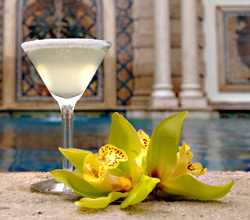It’s not often Seattle Weekly falls victim to the blandishments of a corporate PR department looking to buff one of its brands. But when the buffing is done expertly and the pitch delivered informatively, acknowledgment should be made. So I hereby raise a glass to the Jose Cuervo people, who came to town a few months ago determined to show Seattle that tequila, unlike other strong spirits, makes a grand accompaniment for food. Cuervo (a family-owned company based in the town of Tequila itself) may be the world’s biggest company in the field and its brashest, most successful marketer of tequila as the ultimate fun-in-the-sun beverage. But they also want to show the world that they sell great tequila, a drink as good in its way as great brandy.
Well, they showed me. I’ve been to demonstration dinners promoting Kentucky bourbon with food, single-malt scotch with food, even straight vodka with food, and in every case the verdict was “not proven.” A smart chef can contrive a dish that goes with pretty much any beverage, but no chef in my experience has been able to work up a whole menu that pulls it off.
Last summer, Jason Wilson of Crush batted a beautiful .833, connecting on five of six chances for a banquet pairing tequila cocktails with everything from oysters to foie gras. Only the grilled lamb chop and a sort of agave mojito topped with zinfandel foam missed: Individually agreeable, they remained standoffish with each other, like one of those couples you remind yourself never to invite together again. (But the drink was originally planned to be served with short ribs, so maybe it would work in its intended context.)
Why should tequila work so well with so many different flavor combinations? One reason, I suspect, is that tequila’s basic flavor remains closer to its origin as a vegetable extract than most spirits. Distillers spend a lot of time taming their raw spirits in a variety of aging media. Tequila normally spends little time in barrel and stays truer to the blue agave it’s made from.
Another reason may be that the three “grades” of tequila—blanco/plata, reposado, and añejo—are more like three variations on a flavor theme than price-point labels. You can’t count on a particular manufacturer’s reposado (aged up to a year) being “smoother” than his añejo, which may spend three years or more in wood. Indeed, añejos frequently have more of the characteristic woody, vegetal tequila bite than less aged versions.
With superpremium tequilas like Cuervo’s Gran Centanario brand, you don’t save much money by buying blanco (GC calls theirs by the tonier term plata, Spanish for silver) instead of reposado or añejo. What you get is a different spirit; simpler, perhaps, but with a distinct flavor profile of its own. For solo sipping, well-aged añejo is probably your best choice. But for serving with food, you need experience (or the assistance of a good mixologist) to find the brand and grade that will suit your guests and your menu.
Cuervo provided just such an individual at its June trade dinner at Crush. Francesco Lafranconi’s day job is director of promotion for the Nevada branch of Southern Wine and Spirits (the nation’s biggest distributor of same), but he hasn’t lost the shaker skills that made him a star at Harry’s Bar in Venice.
The most startling yet most successful of the six cocktails contrived by Lafranconi for the Crush dinner was a 3-2-1 blend of reposado, pomegranate juice infused with earthy pu-erh tea leaves, and medium-dry sherry, dusted with coriander and alder-smoked salt, served with an oyster “stew” of bitter-lovage cream, bacon, and agave- lemon essence. Weird? Assuredly. Don’t try this at home? Probably. But utterly memorable on the palate, with all the complex smooth, tart, smoky, and sweet flavors working together.
The foie gras presentation, in contrast, was utterly simple: the liver cleaned, marinated, poached, chilled as a torchon, and served with the traditional toast points, a frizzle of fresh greens, and a dab of pungent fruit compote (chef Wilson chose rhubarb). Lafranconi’s bibulous riposte was a wonder: ice wine and reposado 4-to-1, barely citrus-scented with a tiny spiral of kumquat. The cocktail (called an Ángel Cortez) is a little miracle. Not only does it make practical use of one of kitchen-dom’s most unnecessary ingredients, it also makes ice wine something more than cloying and forgettable. Since you can chill the hell out of both liquids (and the glasses, too), and since the alcohol level of the finished drink is rather lower than a typical glass of wine, you can forget the foie gras and serve a shakerful as a predinner cocktail without worrying about ruining your guests’ palates or sending them home blotto.
I don’t know if I’ve persuaded you to give tequila a try as an accompaniment to serious food. Ultimately, you need to experiment and convince yourself that there is a world beyond wine at the dinner table. You can find recipes for Lafranconi’s other food-oriented tequila cocktails on Gran Centenario’s Web site (www.gran centenario.com). But you don’t need to get elaborate to prove my point. Just shake yourself up a classic 3-2-1 margarita with a good añejo, real Grand Marnier, and fresh lime juice. On its own or with tangy food (may I suggest a plate of spaghetti bolognese or a homemade paella?), there’s no going back.








